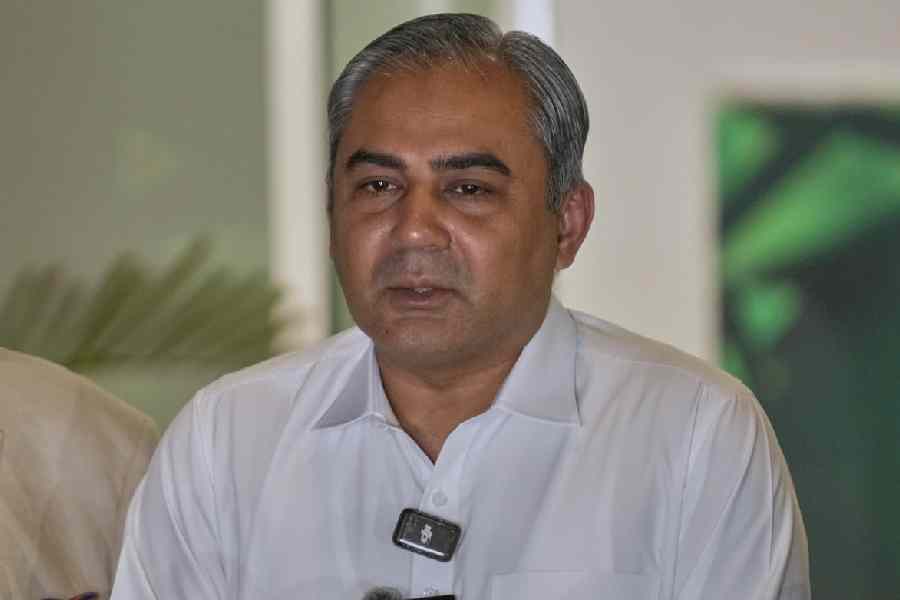
Patna, Sept. 19: A chaiwala (tea-seller) has become Prime Minister, but the taste of chai (tea) has lost its charm in Bihar, albeit for more earthy reasons.
It is because kulhar or chukaar - a biodegradable container made of clay in which tea is often served in Bihar - is fast fading away and getting replaced with disposable plastic cups.
Kulhar is made of kewal (black) clay, a ball of which is put on a turntable of the chaak, a round plate that rotates with the help of a stick, helping give the kulhar its shape. Once the shape is established, the kulhars are roasted over a homemade kiln of charcoal or cow dung fire for over two days.
Potters in the state still prefer the traditional style to the variable-speed electric motor potter's wheel. "I am comfortable with the stick. It gives me the feel that things are still under control," said Kishun Pandit, a 65-year-old potter from Shahpur in Maner.
While the tool has survived the challenge from technology, the product and the manufacturer are quietly fading away in the absence of demand. "There was a time when chai was incomplete without kulhar. Evenings were reserved for kulhar chai. But things have changed now. My son refused to become a potter. He chose to be a tailor and is employed all seasons, unlike me who gets work only during Diwali," said Kishun, emphasising that his name begins with a K. "Last time, somebody wrote Trishun instead of Kishun. I have picked up a little bit of English from learned people in whose bungalows I did pottery long ago." That sounds so much like the Prime Minister picking up Hindi while selling tea, something he confessed recently.
Returning to the kulhar, Kishun said: "No, we don't make kulhars now, unless there is a special demand. Kulhars of bigger size are manufactured for use during cremations."
In fact, asked to show some kulhars in his collection, Kishun had to search for long until he fished out 10 pieces of dust-filled, cob-webbed and faded kulhars that were at least two years old. "See their condition. These are no more in demand. We are in naya-yug now," said a disappointed Kishun.
Potters across the city echoed Kishun. "The demand for kulhar has dwindled after the introduction of disposable plastic cups. Twenty years ago, kulhars were in great demand. We used to charge Rs 10 for 100 kulhars. We used to get orders in lakhs," said Ram Nagina Pandit, a 35-year-old potter who has been looking after his ancestral business at Mobarakpur near Danapur.
But things are fast changing in Bihar, the birthplace of the kulhar. "We pay Rs 2,000 per tractor of clay and it comes from Naubatpur. The cost of manufacturing one kulhar is 60 paise now. We now charge around Rs 50 for 100 kulhars," he said.
Seeing that making kulhars makes poor business sense now, Maner-based Devendra Prasad Prajapati (45), whose ancestors were in the pottery business, has opted to become a mechanic. "Pottery requires money, effort, art and hard work. Charcoal, clay, sand and cow-dung cake - the four basic elements required for making kulhars - are getting costlier by the day. I saw my father spending hours on potter's wheels and getting nothing. I wanted a secure future. Even my uncle, a potter, is struggling. He finds employment from mid-August till November, after which he works at a kiln. I didn't want a miserable life like his," Devendra said.
Kishun supported Lalu Prasad when he decided as Union railway minister in 2004 to make use of kulhar compulsory for sale of tea and other beverages at railway stations and aboard trains, so as to revive the trade. Kishun said: "He was the only leader who encouraged potters to pass on this art to the next generation. But things changed after 2004. Now people love fancy things. You give them raw kulhar, they will refuse to drink tea in it. But if you paint it and give it a design, they will find it creative."
Vishal Sahay, a 31-year-old entrepreneur who runs Kulhar Chai, a joint on S. K Puri Road where chai is served in kulhars, has helped take kulhars to the youth and revive it. "Chai is the most saleable item. But I wanted kulhars to reach the youth. At most tea joints now you get tea in disposable cups. My plan was to revive tea made in charcoal and the kulhar. I loved Laluji's idea of serving tea in kulhars, which are also eco-friendly. Somehow the idea was trashed, but it tickled my brain cells and gave me an idea to work on. We order around 15,000 kulhars a month," said Vishal. Incidentally, the ethnic touch to tea fetches Rs 15 per kulhar. Only Re 1 goes to the potter.










